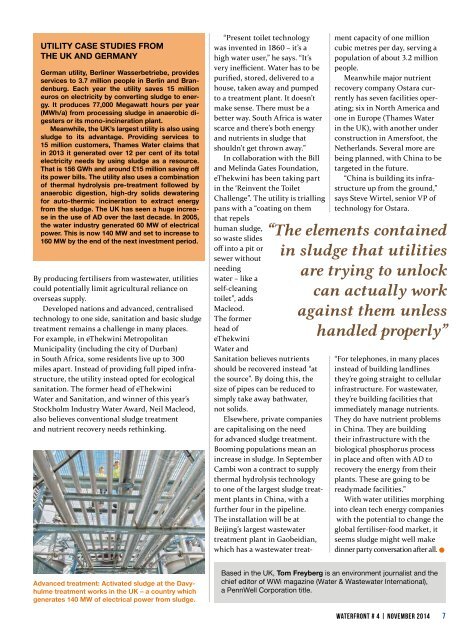Waterfront, #4, November 2014
Create successful ePaper yourself
Turn your PDF publications into a flip-book with our unique Google optimized e-Paper software.
UTILITY CASE STUDIES FROM<br />
THE UK AND GERMANY<br />
German utility, Berliner Wasserbetriebe, provides<br />
services to 3.7 million people in Berlin and Brandenburg.<br />
Each year the utility saves 15 million<br />
euros on electricity by converting sludge to energy.<br />
It produces 77,000 Megawatt hours per year<br />
(MWh/a) from processing sludge in anaerobic digesters<br />
or its mono-incineration plant.<br />
Meanwhile, the UK’s largest utility is also using<br />
sludge to its advantage. Providing services to<br />
15 million customers, Thames Water claims that<br />
in 2013 it generated over 12 per cent of its total<br />
electricity needs by using sludge as a resource.<br />
That is 156 GWh and around £15 million saving off<br />
its power bills. The utility also uses a combination<br />
of thermal hydrolysis pre-treatment followed by<br />
anaerobic digestion, high-dry solids dewatering<br />
for auto-thermic incineration to extract energy<br />
from the sludge. The UK has seen a huge increase<br />
in the use of AD over the last decade. In 2005,<br />
the water industry generated 60 MW of electrical<br />
power. This is now 140 MW and set to increase to<br />
160 MW by the end of the next investment period.<br />
By producing fertilisers from wastewater, utilities<br />
could potentially limit agricultural reliance on<br />
overseas supply.<br />
Developed nations and advanced, centralised<br />
technology to one side, sanitation and basic sludge<br />
treatment remains a challenge in many places.<br />
For example, in eThekwini Metropolitan<br />
Municipality (including the city of Durban)<br />
in South Africa, some residents live up to 300<br />
miles apart. Instead of providing full piped infrastructure,<br />
the utility instead opted for ecological<br />
sanitation. The former head of eThekwini<br />
Water and Sanitation, and winner of this year’s<br />
Stockholm Industry Water Award, Neil Macleod,<br />
also believes conventional sludge treatment<br />
and nutrient recovery needs rethinking.<br />
“Present toilet technology<br />
was invented in 1860 – it’s a<br />
high water user,” he says. “It’s<br />
very inefficient. Water has to be<br />
purified, stored, delivered to a<br />
house, taken away and pumped<br />
to a treatment plant. It doesn’t<br />
make sense. There must be a<br />
better way. South Africa is water<br />
scarce and there’s both energy<br />
and nutrients in sludge that<br />
shouldn’t get thrown away.”<br />
In collaboration with the Bill<br />
and Melinda Gates Foundation,<br />
eThekwini has been taking part<br />
in the ‘Reinvent the Toilet<br />
Challenge”. The utility is trialling<br />
pans with a “coating on them<br />
that repels<br />
human sludge,<br />
so waste slides<br />
off into a pit or<br />
sewer without<br />
needing<br />
water – like a<br />
self-cleaning<br />
toilet”, adds<br />
Macleod.<br />
The former<br />
head of<br />
eThekwini<br />
Water and<br />
Sanitation believes nutrients<br />
should be recovered instead “at<br />
the source”. By doing this, the<br />
size of pipes can be reduced to<br />
simply take away bathwater,<br />
not solids.<br />
Elsewhere, private companies<br />
are capitalising on the need<br />
for advanced sludge treatment.<br />
Booming populations mean an<br />
increase in sludge. In September<br />
Cambi won a contract to supply<br />
thermal hydrolysis technology<br />
to one of the largest sludge treatment<br />
plants in China, with a<br />
further four in the pipeline.<br />
The installation will be at<br />
Beijing’s largest wastewater<br />
treatment plant in Gaobeidian,<br />
which has a wastewater treat-<br />
ment capacity of one million<br />
cubic metres per day, serving a<br />
population of about 3.2 million<br />
people.<br />
Meanwhile major nutrient<br />
recovery company Ostara currently<br />
has seven facilities operating;<br />
six in North America and<br />
one in Europe (Thames Water<br />
in the UK), with another under<br />
construction in Amersfoot, the<br />
Netherlands. Several more are<br />
being planned, with China to be<br />
targeted in the future.<br />
“China is building its infrastructure<br />
up from the ground,”<br />
says Steve Wirtel, senior VP of<br />
technology for Ostara.<br />
“The elements contained<br />
in sludge that utilities<br />
are trying to unlock<br />
can actually work<br />
against them unless<br />
handled properly”<br />
“For telephones, in many places<br />
instead of building landlines<br />
they’re going straight to cellular<br />
infrastructure. For wastewater,<br />
they’re building facilities that<br />
immediately manage nutrients.<br />
They do have nutrient problems<br />
in China. They are building<br />
their infrastructure with the<br />
biological phosphorus process<br />
in place and often with AD to<br />
recovery the energy from their<br />
plants. These are going to be<br />
readymade facilities.”<br />
With water utilities morphing<br />
into clean tech energy companies<br />
with the potential to change the<br />
global fertiliser-food market, it<br />
seems sludge might well make<br />
dinner party conversation after all.<br />
Advanced treatment: Activated sludge at the Davyhulme<br />
treatment works in the UK – a country which<br />
generates 140 MW of electrical power from sludge.<br />
Based in the UK, Tom Freyberg is an environment journalist and the<br />
chief editor of WWi magazine (Water & Wastewater International),<br />
a PennWell Corporation title.<br />
WATERFRONT # 4 | november <strong>2014</strong><br />
7


















